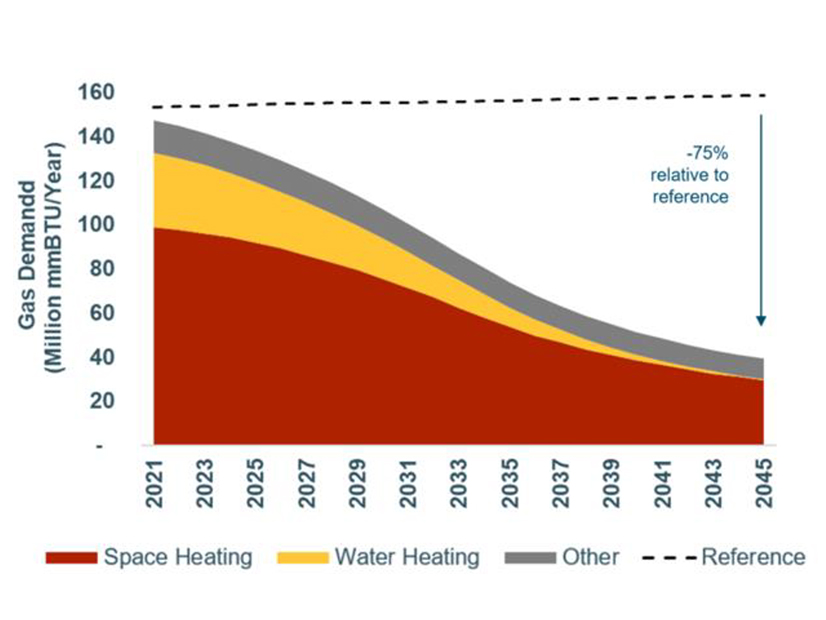
Maryland’s Climate Change Commission should recommend the General Assembly order the Building Code Administration to adopt an all-electric construction code, according to one of its working groups.
An overhauled code would ensure “that new buildings meet all water and space heating demand without the use of fossil fuels. A cost-effectiveness test would allow building projects to seek variances to code requirements while maintaining electric-ready standards,” the commission’s Greenhouse Gas Mitigation Work Group (MWG) said in a report on building decarbonization it approved Oct. 13 for submission to the full commission.
The MWG advanced the plan following a series of meetings earlier this year in which the consultancy Energy and Environmental Economics (E3) presented several scenarios for building decarbonization. (See Maryland Looks at Pathways to Net Zero Buildings by 2045.)
One was a high-electrification scenario, in which almost all buildings would switch to air-source or ground-source heat pumps; a second involved electrification with gas backup, in which existing buildings would keep using fuels for heating, albeit with heat pump backups, while new buildings would be required to have all-electric heat; and a third involved high decarbonized methane, in which buildings would keep using fuels for heating, but fossil fuels would gradually be replaced by low-carbon renewable fuels.
Least-cost Plan
In the end, however, the MWG’s Buildings Sub-Group adopted its own, least-cost vision, in consultation with E3. It is based on “four core concepts”:
- “ensure an equitable and just transition, especially for low-income households”;
- “construct new buildings to meet space and water heating demand without fossil fuels”;
- “replace almost all fossil fuel heaters with heat pumps in existing homes by 2045”; and
- “implement a flexible building emissions standard for commercial buildings.”
According to E3, under the plan Maryland would reduce emissions from residential and commercial buildings by 95% by 2045. Gas system investments would be reduced enough to save about $1 billion annually, money that could be reinvested to ramp up electricity system investments. Electricity rates would go up by only 2 cents/kWh, while construction and energy costs would go down for most building types, and gas rates would be lower than all the scenarios E3 modeled.
To get there, the MWG suggested the commission make four core recommendations to the General Assembly, including the proposed all-electric construction code.
The second is to develop a clean heat retrofit program, which would require the legislature to reauthorize the EmPOWER Maryland energy-efficiency program to continue after 2023. It would also have to encourage fuel-switching and beneficial electrification through EmPOWER beginning in 2024, targeting 50% of residential heating and cooling systems and water heater sales to be heat pumps by 2025, rising to 95% by 2030. By that same year, 100% of low-income houses would have to be retrofitted with clean heat.
A third recommendation is to have the Maryland Department of the Environment create a building emissions standard, under which state-owned buildings would have to achieve net-zero emissions by 2035 and commercial and multifamily residential buildings by 2040. An interim goal of a 50% reduction in direct emissions from covered, non-state-owned buildings by 2030 was removed at the Oct. 13 session and will instead be considered for review in the 2022 MWG Work Plan.
“The General Assembly should also provide tax incentives and resources to help owners of covered buildings develop and implement emissions reduction measures,” the report says. “An alternative compliance pathway would be available to allow covered buildings to continue using fossil fuels when emissions reduction measures are unnecessarily expensive.”
Finally, the MWG recommended that the Public Service Commission develop a utility transition plan “whereby the electric and gas utility companies develop plans for achieving a structured and just transition to a near-zero emissions buildings sector in Maryland.”
The Climate Change Commission had not received broader recommendations for greenhouse gas reductions by the official Wednesday deadline for inclusion in its upcoming annual report. Most work group members did not feel ready to vote Tuesday on a sweeping set of recommendations covering everything from water and soil management to the Regional Greenhouse Gas Initiative. Susan Casey, director of communications for the Climate Change Program at the Maryland Department of the Environment, told NetZero Insider in an email that those recommendations need more clarification before a vote.

